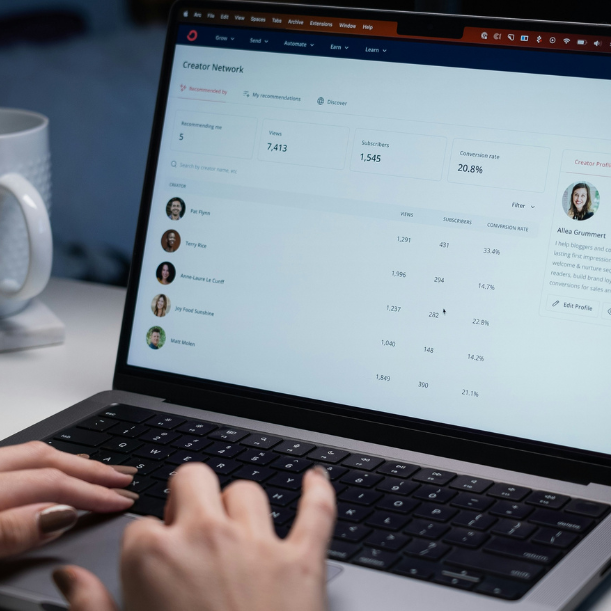An AI recruitment platform is much more than just a piece of software; think of it as a strategic partner for your talent team. It’s designed to handle the repetitive, high-volume tasks that often bog down the hiring process, but with exceptional speed and precision. This is an intelligent system that uses technologies like machine learning and natural language processing to automate the entire hiring lifecycle, from sourcing candidates right through to scheduling interviews.
Your Digital Chief of Staff
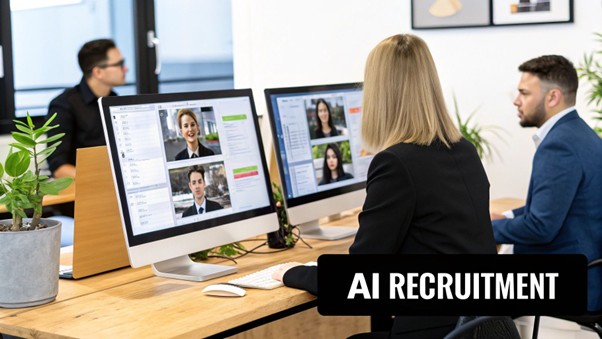
Picture the most efficient person on your team—the one who flawlessly organises everything, tackles the tedious admin, and perfectly preps you for every important meeting. Now, imagine that role amplified by the power of technology. That’s the essence of an AI recruitment platform. It acts as a digital chief of staff for your entire talent acquisition function.
It doesn’t just manage tasks; it intelligently streamlines them. Recruiters can spend up to 40% of their week on administrative duties, but this platform takes over. It can sift through thousands of résumés in mere minutes, identifying the best-fit candidates based on nuanced skills rather than just simple keywords, and even coordinate complex interview schedules across multiple time zones.
What Makes It Intelligent
The “intelligence” comes from the platform’s ability to learn and adapt over time. Unlike traditional software that just follows a rigid set of pre-programmed rules, an AI recruitment platform actually gets smarter with use. It analyses which candidates end up being successful in your organisation and then refines its search criteria to find more people just like them. This continuous learning process is what elevates it from a simple software tool into a true strategic asset.
This kind of intelligent automation is absolutely crucial in today’s competitive talent market. It frees up your human recruiters to step away from the keyboard and do what they do best:
- Building real relationships with top-tier candidates.
- Conducting meaningful interviews that truly assess cultural fit and long-term potential.
- Crafting compelling offers that secure the best talent for your team.
By automating the transactional parts of hiring, an AI recruitment platform elevates the role of the recruiter. It transforms them from process managers into strategic talent advisors who can focus on human connection and long-term value.
From Manual Effort to Strategic Impact
Just think about the typical hiring process for a moment. Manually posting a job to dozens of boards, screening every single application that comes in, and the endless back-and-forth emails to schedule one interview is a logistical nightmare. It’s slow, prone to human error, and creates a poor experience for candidates who are left waiting for weeks on end.
An AI-driven system completely flips this model on its head. A single click can distribute a job posting to the most effective channels, chosen based on past performance data. As applications pour in, the system screens and ranks them instantly, presenting recruiters with a prioritised shortlist of the most promising candidates. This is just one of the ways a recruitment platform eases digital hiring, shifting the focus from manual labour to strategic decision-making.
Ultimately, this technology acts as a powerful force multiplier. It equips your team to make smarter, faster, and more data-driven hiring decisions, ensuring you not only fill roles quickly but fill them with the right people who will drive your organisation forward.
The Real-World Payoffs of Bringing AI into Recruitment
Let’s move past the theory and talk about what this means for your business. An AI recruitment platform isn’t just a shiny new tool; it delivers tangible results that hit the bottom line. For a Chief Human Resources Officer, this is about transforming talent acquisition from a cost centre into a strategic, data-smart powerhouse. The benefits are much bigger than simple automation—they fundamentally change how you find, assess, and bring top talent on board.
Think of these platforms as a powerful engine for your recruitment team. They take on the high-volume, repetitive tasks that eat up so much time. This frees up your recruiters to do what they do best: building relationships with candidates and making those crucial hiring calls.
Hitting Fast-Forward on the Hiring Cycle
In today’s market, speed is everything. The longer it takes to fill a key role, the more it can impact your projects and even your revenue. An AI recruitment platform massively cuts down the time-to-hire by automating the slowest parts of the process.
Picture sifting through thousands of résumés. Doing that by hand can take days, if not weeks. An AI system can do it in minutes, instantly shortlisting and ranking the most qualified people based on the skills and experience you actually need.
This speed boost extends to scheduling, too. Trying to coordinate interviews between candidates, recruiters, and hiring managers is a logistical nightmare. AI tools solve this by syncing with calendars and letting candidates book their own slots from available times. One study even found that automated scheduling alone slashed the time needed to set up an interview by more than 85%.
By turning administrative work that takes days into tasks that take hours, an AI platform gets you in front of top candidates before your competitors even have a chance. In the race for in-demand talent, that speed is your secret weapon.
Boosting Hire Quality and Cutting Out Bias
Of course, speed is useless if you aren’t hiring the right people. The end goal is to bring in talent who will not only succeed but also stick around and grow with the company. An AI recruitment platform lifts the quality of hire by using smart, data-driven algorithms to spot the best-fit candidates, going way beyond simple keyword matching.
These systems dig deep, analysing a candidate’s skills, experience, and potential against the real competencies needed for the job. This objective, data-first approach helps push back against the unconscious biases that can creep into human decision-making. By zeroing in on qualifications and proven abilities, AI levels the playing field for every applicant.
- Skill-Based Matching: AI is brilliant at spotting transferable skills and relevant experience that a human recruiter might accidentally skim over.
- Bias Mitigation: The system focuses on objective data points, which means factors like a person’s name, gender, or university don’t improperly influence the initial screening.
- Predictive Insights: Some advanced platforms can even analyse patterns from your past successful hires to predict which new candidates have the highest likelihood of succeeding in a similar role.
This focus on objective criteria doesn’t just lead to better hires; it helps build a more diverse and inclusive team. And better hiring decisions directly lead to stronger employee performance and improved retention, saving you from the high cost of turnover.
Crafting a Better Candidate Experience
A potential employee’s first interaction with your company sets the stage for everything that follows. A clunky, slow, or silent application process is a surefire way to lose top talent and hurt your employer brand. An AI recruitment platform helps you create a smooth, modern, and engaging experience from the very beginning.
Think of AI-powered chatbots that give applicants 24/7 support, instantly answering their questions about a role or where they stand in the process. This kind of constant communication keeps people engaged and shows them you value their time—a small touch that makes a huge difference.
This is especially critical in a rapidly growing market. For instance, India’s recruitment industry is set for massive growth, with forecasts pointing to a 19% jump in hiring intent and the creation of around 500,000 new jobs by 2025. In that kind of environment, a top-notch candidate experience is what will make you stand out. You can explore the full Indian recruitment outlook and its growth drivers to get a sense of the scale here. By adopting an AI-driven approach, you can build a powerful employer brand that attracts the very best talent in a booming market.
Essential Features of a Modern AI Recruitment Platform
To really get a feel for the power of an AI recruitment platform, we need to look under the bonnet. Not all platforms are built the same, and for any CHRO looking to make a smart tech investment, understanding the core features is absolutely critical. These aren’t just flashy bells and whistles; they are the engine parts that drive real efficiency, boost the quality of your hires, and deliver a far better experience for candidates.
Think of these features as the specialised members of a highly efficient digital hiring team. Each has a distinct role, but they all work in concert towards one goal: finding and securing the best talent for your organisation, faster and more effectively than ever before.
Intelligent Sourcing and Talent Discovery
The first, and maybe the most crucial, feature is intelligent sourcing. This is light-years beyond just posting a job and hoping for the best. Modern platforms proactively scan millions of online profiles from professional networks, niche job boards, and other public data sources to find passive candidates. These are the skilled professionals who aren’t actively looking but would be a perfect fit for your role.
Using machine learning, these systems understand the real meaning behind a job description. They don’t just hunt for keywords; they identify related skills and experiences, uncovering hidden gems that a manual search would almost certainly miss. This builds a dynamic, pre-qualified talent pipeline, ensuring you always have a pool of strong candidates ready to go when a new role opens up.
A powerful AI recruitment platform acts like a virtual talent scout, continuously mapping the market to find your next great hire before you even know you need them. It shifts recruitment from a reactive process to a proactive, strategic function.
Automated Screening and Candidate Matching
Once you have a pool of applicants, the next big hurdle is figuring out who the best ones are. This is where automated screening comes in, tackling what is often a monumental task. An AI algorithm can analyse thousands of résumés in minutes, accurately matching them against your specific job criteria with incredible precision.
This is where you see some of the most dramatic time savings.
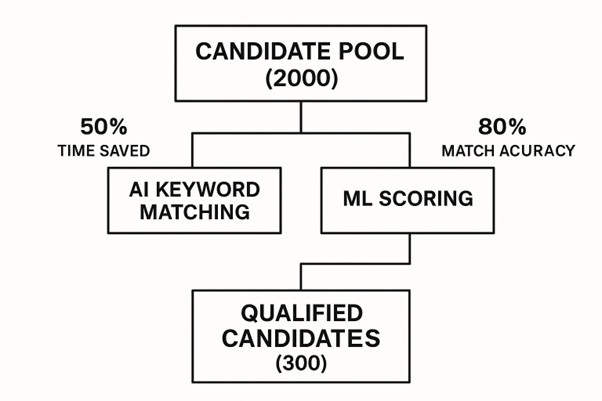
As you can see, AI-driven matching and scoring can efficiently whittle down a massive pool of 2,000 candidates to just 300 highly qualified individuals. The result? High match accuracy and screening time cut in half.
To put it all into perspective, here’s a quick look at the key features and the value they bring directly to you as a CHRO.
Key Features and Their Strategic Impact
| Feature | Core Technology | Primary Benefit to CHROs |
| Intelligent Sourcing | Machine Learning, Natural Language Processing | Proactively builds a pipeline of passive talent, reducing time-to-fill and reliance on active job seekers. |
| Automated Screening | AI-driven Algorithms, Semantic Matching | Drastically cuts down on manual review time, allowing recruiters to focus on engaging top-tier candidates. |
| Predictive Analytics | Predictive Modelling, Data Analysis | Provides data-backed insights on candidate success potential, improving hire quality and long-term retention. |
| AI-Powered Chatbots | Natural Language Processing, Conversational AI | Enhances candidate experience with 24/7 support, strengthening employer brand and keeping applicants engaged. |
| Automated Scheduling | Calendar Integration, API Automation | Eliminates administrative bottlenecks, freeing up significant recruiter time for more strategic activities. |
These features work together to create a system that’s not just faster, but fundamentally smarter.
Predictive Analytics for Smarter Decisions
Going beyond just matching skills on a résumé, advanced platforms use predictive analytics to forecast a candidate’s potential for success within your company culture. By analysing data from your past successful hires—their skills, tenure, and performance reviews—the AI identifies patterns and attributes that correlate with long-term success at your organisation.
This data-driven insight gives hiring managers a more objective layer of analysis to complement their own intuition. It helps reduce the risk of making a bad hire and directly impacts employee retention for the better. It finally provides a concrete answer to that all-important question: “Which of these candidates is most likely to truly thrive here?”
AI-Powered Chatbots and Candidate Engagement
In today’s market, a positive candidate experience is non-negotiable, and AI chatbots have become a cornerstone of modern engagement. These bots act as a 24/7 concierge for applicants. They can instantly answer common questions, provide real-time updates on an application’s status, and guide candidates through the first few steps of the hiring process.
This constant, helpful communication keeps candidates engaged and informed, creating a positive impression of your employer brand from the very first touchpoint. In India, where AI adoption in recruitment is accelerating, this is quickly becoming a standard expectation. A remarkable 93% of hiring managers in the country reportedly accept candidates using generative AI to improve their résumés, signalling a major cultural shift. This trend only underscores the growing role of AI tools like chatbots in elevating candidate communication. You can learn more about AI’s impact on the Indian recruitment market to see how these tools are reshaping hiring norms.
Automated Interview Scheduling
Let’s be honest, one of the most tedious and time-consuming administrative tasks in recruitment is simply coordinating interviews. Automated scheduling tools completely eliminate this logistical headache.
The platform syncs with the calendars of the hiring manager and interviewers, then allows the candidate to simply pick an available slot that works for them. No more back-and-forth emails. This one feature can save recruiters countless hours. Just look at Electrolux—they reported saving 78% of their time on scheduling alone after bringing in an AI platform. That’s a staggering efficiency gain that frees up recruiters to focus on what they do best: building relationships with great candidates.
How to Choose the Right AI Recruitment Platform
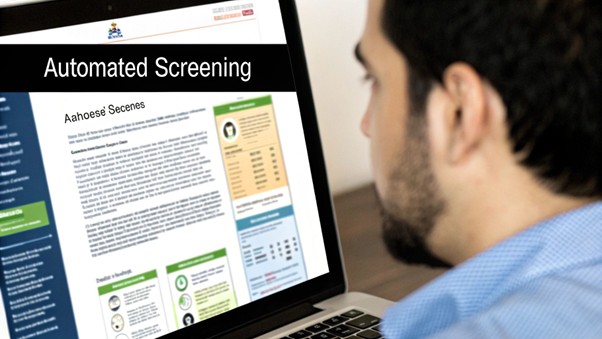
Picking the right technology partner is a huge strategic decision. Choosing an AI recruitment platform isn’t like buying off-the-shelf software; it’s about starting a relationship that will fundamentally change how you find and hire talent. The market is crowded with vendors, all promising incredible results. To cut through the noise, you need a clear framework to find a solution that genuinely fits your organisation.
The whole process kicks off with a hard look inward. Before you sit through a single demo, you have to get to grips with your own pain points. Are you drowning in applications for high-volume entry-level roles? Is your real challenge sourcing that needle-in-a-haystack passive candidate for a senior position? Or maybe your main goal is simply to create a better candidate experience to boost your employer brand. Defining these objectives is your North Star—it will guide you straight to the platforms that solve your actual problems.
Define Your Core Evaluation Criteria
Once you know what you’re trying to fix, you can build your evaluation checklist. This needs to be specific and measurable, covering everything from the tech specs to the vendor’s reliability.
A non-negotiable starting point is integration capabilities. The platform must play nicely with your existing Human Resource Management System (HRMS) and Applicant Tracking System (ATS). If it doesn’t, you’ll end up with data silos and manual workarounds, which completely defeats the purpose of automation. Ask potential vendors to show you case studies of successful integrations with the systems you already use.
Another massive factor is scalability. The platform you choose today must support your growth tomorrow. Can it handle a sudden hiring spike without breaking a sweat? Can it adapt as you expand into new countries? A truly scalable solution grows with you, not in spite of you.
Choosing an AI recruitment platform is less about the technology itself and more about its alignment with your strategic vision. The right tool should feel like a natural extension of your team, empowering them to achieve goals that were previously out of reach.
Scrutinise Security and Compliance
Data security is, of course, non-negotiable. You’re trusting this platform with highly sensitive candidate and company information, so you must vet each vendor’s security protocols with a fine-tooth comb. Look for certifications and compliance with global data protection regulations. In the Indian context, it’s absolutely vital to understand how the platform aligns with local data privacy laws.
But compliance isn’t just about data security; it’s also about ethical AI. A good vendor should be completely transparent about how their algorithms are built to reduce bias. When you’re in the demo, ask some direct questions:
- How is your AI model trained to ensure fairness and minimise unconscious bias?
- What checks and balances are in place to audit algorithmic decisions?
- Can you explain exactly why a candidate was recommended or rejected?
If a vendor gets cagey or can’t answer these questions with confidence, consider it a major red flag. Ethical AI isn’t just a buzzword; it’s a foundational requirement for building a fair and equitable hiring process. The market for these tools is exploding, making due diligence more important than ever. The AI recruitment market in India, for example, is set to grow from around USD 43.2 million in 2024 to an estimated USD 90.6 million by 2035, driven by major players pouring money into digital transformation. You can explore the full analysis of India’s AI recruitment market growth to get a better sense of the landscape.
Structure a Pilot Program for Validation
Finally, never commit to a full-scale rollout without seeing how the platform performs in your own environment. A structured pilot programme is the single best way to test the tech and see its real-world impact. Pick a specific department or role to pilot the platform and establish clear Key Performance Indicators (KPIs) to measure success.
Keep a close eye on metrics like time-to-hire, quality of the shortlisted candidates, and feedback from your recruiters. This hands-on experience will give you insights that no slick sales demo ever could. For a deeper look at modernising your hiring model, you might find our guide on digital RPO for high-impact hiring useful. Ultimately, this approach will help you make a smart, data-backed decision that delivers a clear and measurable return on investment
Implementing an AI Platform in Your Hiring Process
Bringing an AI recruitment platform into your workflow is so much more than a simple tech upgrade. Think of it as a strategic shift that touches your people, processes, and overall culture. To get it right, you need a solid plan that ensures the technology truly helps your team, rather than just adding another layer of complexity. It’s all about managing the change carefully and showing real value every step of the way.
It’s a bit like giving a team of seasoned drivers a brand-new, highly advanced navigation system. You can’t just install it in their cars and expect them to master it overnight. You have to demonstrate how it makes their routes faster, train them on all the cool features, and ultimately prove it helps them get where they’re going more efficiently
Kicking Off with a Phased Rollout
Going for a “big bang” launch—where everything changes at once—is almost always a recipe for chaos. A much smarter approach is a phased rollout, starting with a focused pilot programme. This lets you test the waters in a controlled setting, collect valuable feedback, and build a compelling case before going all-in.
To begin, pick a specific department or a few high-volume roles where you can quickly see the impact. For example, you could pilot the platform for your IT or sales hiring, since these areas usually have clear metrics and a flood of applicants. This initial test run helps you iron out any wrinkles and perfect your strategy before a company-wide launch.
The goal of a pilot is to prove value, not perfection. By focusing on a small, measurable project, you can generate early wins that build momentum and secure buy-in from even the most sceptical stakeholders across the organisation.
Securing Buy-in and Managing Change
Often, the biggest obstacle to any new tech isn’t the technology itself—it’s the people. Your recruiters and hiring managers have to see the platform as a helpful tool, not something that’s trying to replace them. This is where effective change management is non-negotiable.
Start by being crystal clear about the “why.” Frame the AI recruitment platform as an assistant that takes over the tedious, administrative work they dread, like sifting through hundreds of irrelevant CVs or coordinating interview schedules. This frees them up to do what they do best: building meaningful relationships with top-tier candidates.
- Involve Your Team Early: Get your recruiters’ input during the selection process. Their on-the-ground insights are priceless for picking a platform that solves real-world problems.
- Identify Internal Champions: Find those recruiters who are genuinely excited about the new system. They can act as advocates, sharing their positive experiences and encouraging their colleagues.
- Provide Comprehensive Training: Don’t just do one generic training session. Offer hands-on workshops tailored to different users—recruiters, hiring managers, and administrators will all use the platform differently.
Configuring the AI and Migrating Data
Once your team is on board, it’s time to get into the technical details. This means configuring the AI to match your company’s specific hiring criteria and culture. You’ll need to work closely with your vendor to “teach” the AI what an ideal candidate looks like for your roles, making sure it flags the right skills and attributes.
Moving data from your old systems is another make-or-break step. A clean, organised data transfer is essential for the AI to learn from your past hiring successes and failures. This is also the perfect opportunity to tidy up your existing talent database, making sure all the information is accurate and current.
Ultimately, a well-executed implementation ensures the technology enhances, rather than replaces, the invaluable judgment of your recruitment team. For a more structured look at modernising your hiring process, our guide on the 7 steps for digital hiring using recruitment technology offers some great additional insights. By blending smart technology with a human-first approach, you can truly transform your talent acquisition function.
The Future of AI in Talent Acquisition
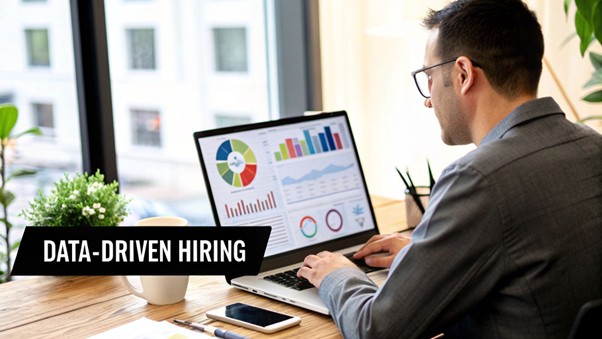
The evolution of the AI recruitment platform is really just getting started. As we look to the horizon, the technology is moving far beyond simple automation. It’s becoming a deeply embedded, predictive partner in how we think about our entire workforce strategy. This next wave won’t just make hiring faster; it’s set to completely reshape how organisations understand, grow, and deploy their people.
One of the most exciting shifts we’re seeing is the move towards hyper-personalised candidate outreach. Picture this: an AI that doesn’t just surface a passive candidate’s profile but actually crafts a message referencing a specific project they championed or a new skill they recently listed online. This kind of bespoke engagement, powered by generative AI, makes your outreach feel less like a mass mailer and more like a personal invitation. The impact on response rates is dramatic.
Unlocking Internal Potential
Beyond just finding new people, the real future of AI in recruitment lies in nurturing the talent you already have in-house. An advanced AI recruitment platform is on its way to becoming the central nervous system for internal mobility. By constantly mapping the skills of your current team against the company’s future needs, these systems can proactively flag employees who are perfect candidates for upskilling or a move to a different department.
For a CHRO, this is a game-changer for tackling both retention and nagging skills shortages. The platform can:
• Analyse skill gaps across the organisation in real-time, highlighting where you’re most vulnerable.
• Recommend personalised learning paths for employees, getting them ready for roles that don’t even exist yet.
• Create a dynamic internal talent marketplace, seamlessly matching your people with projects and open positions that fit their career ambitions.
This kind of proactive approach transforms your company into a place of genuine opportunity, which naturally boosts engagement and slashes the high costs tied to recruiting externally.
The next generation of AI in talent acquisition will be less about filling empty seats and more about building a resilient, agile workforce from within. It’s about seeing the potential in every employee and providing them with a clear path to grow.
The Rise of Predictive Workforce Planning
Finally, AI is poised to become an indispensable tool for predictive workforce planning. By crunching data from market trends, internal turnover rates, and business growth projections, these platforms will be able to forecast your future hiring needs with stunning accuracy. This lets you shift from a reactive hiring model—scrambling when someone leaves—to a proactive one, building strong talent pipelines long before a critical role ever becomes vacant.
Of course, at the heart of this future is a solid commitment to ethical AI. As algorithms become more and more influential in hiring decisions, the demand for total transparency will only grow. The platforms that will lead the pack are the ones that can clearly demonstrate fairness, mitigate bias, and prove that technology is there to empower human judgment, not replace it.
Ready to see how a strategic AI partner can transform your hiring outcomes? Discover how Taggd can help you build a faster, smarter, and more effective talent acquisition function







